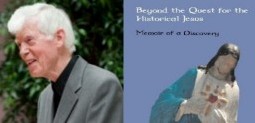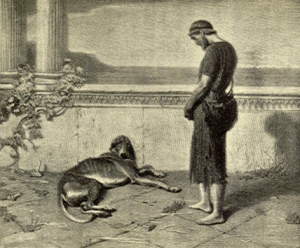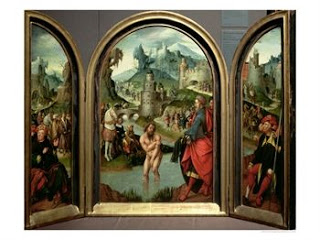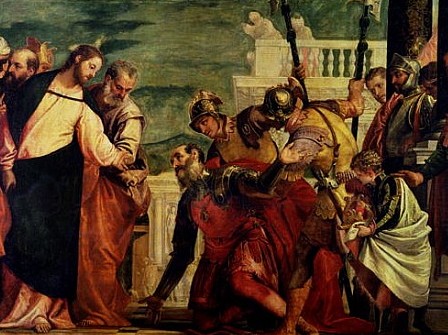 Chapter 14
Chapter 14
THE SHIPPING FORECAST: DEEPS BELOW AND A STORM AHEAD
.
Chapter 14 of Thomas Brodie’s Memoir of a Discovery is probably one of the volume’s most significant and it is to be regretted that some of Brodie’s critics have so totally avoided its message. This chapter strikes at the heart of what most of us at first find most challenging about Brodie’s thesis.
But first, let’s start where Thomas Brodie himself starts in this chapter. Let’s begin when he meets the new professor of New Testament at Yale Divinity School, Richard B. Hays, in the 1980s. There is a new wind beginning to blow in New Testament studies and Hays’ work is among those ships that have felt its first gusts. (We will see that many are still in denial and refusing to prepare.) Meanwhile, Hays invited Brodie to speak on Luke’s use of the Old Testament to his New Haven class.
 Richard Hays’ thesis has been published as The Faith of Jesus Christ: The Narrative Substructure of Galatians 3:1-4:11. Hays argues that a section of Galatians is a product of an author reworking a larger narrative about Jesus Christ and some of the Old Testament. Richard Hays’ thesis has been published as The Faith of Jesus Christ: The Narrative Substructure of Galatians 3:1-4:11. Hays argues that a section of Galatians is a product of an author reworking a larger narrative about Jesus Christ and some of the Old Testament.
Since then, Brodie informs us, Hays has become “a pioneer in narrative theology — in showing how New Testament narrative often builds a story or narrative that is grounded on that of the Old Testament”. Others have come along to complement his work. Some of these:
In acknowledging the importance of the Old Testament “allusions” or “echoes” in the New Testament, these works (according to Brodie) are “a real advance for New Testament research.”
|
But there’s a but . . .
Brodie’s optimism is tempered, however. The above “pioneers” speak of “echoes” and “allusions” and for that reason do not really do full justice to the way the New Testament authors re-worked/re-wrote the literature of the Old.
If many scholars have jumped at doing “history” with the Gospels before they have taken care to explore the nature of their literary sources, Richard Hays has been too quick to jump into doing theology. By that Brodie means that Hays has failed to appreciate that questions of theology can be significantly influenced by understanding how the texts being studied came to be put together, how they were transmitted. By understanding how authors put the texts together one can better appreciate the questions of theology they posed in their final products.
Hays can appreciate that the continuity between the narratives of Luke-Acts and of the Old Testament functions to give readers the theological message that they can have assurance in the continuity and reliability of God’s plan. But what he misses, according to Brodie, is that one of the most central factors of God’s plan was the composing of Scripture itself. So by studying the way Scriptures were composed, how they were sourced and put together, we can understand how God worked, how he implemented his plan. For Brodie, such questions are fundamental to truly appreciating the theology of the New Testament writings.
And the ineffectuality of “intertextuality”
The word intertextuality has been frequently used by scholars studying the ways New Testament authors made use of their literary sources but its meaning is also too often imprecise. The word originated with Julia Kristeva in 1966 and today is more commonly associated with anthropological questions of interaction between cultures, Several biblical scholars use the word to refer to concepts as light as “textual allusions” or “echoes”. This is fine insofar as it draws attention to the relationship between written texts. But Brodie is arguing that ancient writing involved much more than “allusions” and “echoes”:
The kernel of ancient writing was not in allusions: it was in taking hold of entire books and transforming them systematically. VIrgil did not just allude to Homer; he swallowed him whole. And there are comparable systematic transformations within the Bible. Allusions and quotations were often little more than decorations and embellishments. (p. 127)
So what is the nature of the textual relationship that is at the core of Brodie’s argument if it’s more than “echoes” and “allusions”?
.
Transforming Texts Beyond Immediate Recognition
Spotting the differences between the following stories earns no points. But spotting the similarities AND being able to coherently explain them might yield rewards. Many scholars have discussed the comparisons of Luke’s narrative with its matches in Matthew 8:5-13 and John 4:43-54. Many commentators of the Lukan narrative have even been aware of the Naaman episode.
But almost no-one noticed — certainly I didn’t — that, to a decisive degree, the centurion consists largely of a transformation of Naaman.
The differences between the texts are great, and it needs careful examination to see the central continuity between them, yet . . . John Shelton, building on brief comments by a few earlier scholars, has put Luke’s systematic dependence on the Naaman account beyond reasonable doubt.
The Naaman text has been transformed beyond immediate recognition. (p. 128)
Ancient writing, Brodie informs us, was quite unlike modern literature in that it was preeminently concerned with the preservation of the past masters.
At the heart of the composition of ancient texts, including biblical texts, lay a visceral instinct for literary preservation. The reason for this deep-seated custom of preservation and re-use seems to lie, in part at least, in a feeling that existing knowledge, stored largely in precious handwritten texts, was not to be taken for granted by was to be thoroughly understood, imitated (imitatio; Greek, mimésis), emulated (aemulatio; Greek, zélos), rewritten (in diverse forms, Near Eastern and Mediterranean) — and thereby preserved. . . . The purpose, then, was both to preserve what existed, and simultaneously to ensure that it was available in fresh form for a further generation. The essential was preservation, not recognition. (p. 128)
We know that Dennis MacDonald tells us that imitating authors liked to leave “flags” to alert readers to where they had cleverly reconstructed an earlier text. For Brodie, however, by no means are all of the imitated texts recognizable. Many are not!
They are hidden, and unless the researcher is alert to the diverse ways in which they may be disguised, they remain hidden — thus concealing much of the heart of the matter.
The problem can scarcely be overstated. (p. 129)
The process of establishing literary links or literary sources can be difficult. Brodie even quotes a passage from George Steiner’s After Babel and wishes they could be engraved in gold on black marble above the corridors where new students walk. I have taken the liberty to go beyond Brodie’s extract and quote directly from Steiner myself slightly more expansively. After pointing to the “manifest dependence of” James Joyce’s Ulysses on Homer’s Odyssey, Steiner points out that
The Homeric text can be set to music in its original wording or in translation. It can serve as caption to a painting or sculpture which illustrates one or another episode. But the painter, sculptor, or choreographer need not cite his source-text. He can imagine, reflect, or enact it with greater or lesser fidelity.
He can treat it in a limitless variety of perspectives ranging from ‘photographic’ mimesis to parody, satiric distortion or the faintest, most arcane of allusions.
It is up to us to recognize and reconstruct the particular force of relation. (How soon does the generally alert but unaided reader catch the detailed echoes of David Copperfield in Dostoevsky’s The Possessed, or the kinship between the fable of Lear and that of Cinderella, particularly when the latter is case in the form, say, of a ballet or a pantomime?) (my formatting. Steiner, After Babylon, p. 447)
So Thomas Brodie begs for the opening of minds beyond the pre-programmed limits of the conventionally taught textual relationships. He returns to the “narrative theology” of Richard Hays and writes:
Among the ‘limitless variety of perspectives‘, narrative theology has an honoured place, but it is best set in the context of three uses that are particularly pertinent in biblical studies. (p. 129)
So what are those “three uses”?
1. Quotation
This one is obvious. (That’s my comment, not Brodie’s, but I don’t think he’d disagree.) I won’t belabour the point with definitions. We quote for the purpose of having words and their source recognized to lend them authority.
2. Narrative Allusion/Echoes
Again, the point of an allusion or echo is that the source text be recognized, otherwise the point of the allusion is lost.
3. Transformation
Here we come to the crux of Brodie’s arguments. The above two are understood well enough but this third one is still largely unexplored.
We know that many biblical scholars and lay readers will flatly reject and scoff at any suggestion of literary dependence if it is “not easily recognizable”. “The differences outnumber the similarities!” is the common refrain. “I simply don’t see the similarities” is another. (Those last two sentences are my own, not Brodie’s, but I believe they point to how Brodie would tiresomely retort if he were a tired man like me right now.)
In this case the older text is so thoroughly reworked that at first sight it is not recognizable. The purpose of this transformation was not to hit people with a clear authoritative quotation . . . or subtly to evoke a theological narrative (à la Richard Hays), but to respect and preserve the text in adapted form so that it fulfils some other function. (p. 130)
What counts, Brodie writes, is not “easy recognition” but whether the connection can truly be established through the application of valid criteria and honest effort.
And the hidden connections are vast — far, far greater in number and volume than connections that are easily recognizable. . . . (p. 130)
The quickly recognizable allusions are few, says Brodie, but those that are “beneath the surface” are by far more numerous.
The time has come for biblical research to move out into the deep. (p. 130)
Transformation of texts is found
across virtually the whole range of ancient literature, nonbiblical and biblical, Old Testament and New . . .
Moreover the evidence for the ways authors transformed texts is steadily increasing and for support of this Brodie cites:
- Fishbane, 1985, 383-91, 500-505
- Harrington and Horgan, 1986, 239-47
- Fischel, 1975
- D. P. Wright, 2009
- Scheid and Svenbro, 1996, for the idea of writing as weaving
- Steiner, 1975, 296-470, for an example of what a detailed analysis might look like
- Brodie, 1978 (doi: 10.1177/014610797800800105)
Other scholars have acknowledged that literary analysis of the Bible “is only in its infancy” (Robert Alter, 1981; Luke Johnson, 1998), and Brodie is saying we have only barely begun the voyage of discovery. We can all see a few allusions and quotations to the OT in the NT. Brodie is comparing these readily visible relationships to the few fish that we see jumping above the ocean’s surface. It is in the deeps below that we find just how many and varied are the fish indicated by these few.
.
Criteria for Recognizing the Presence of Transformed Texts

http://www.heritage-history.com/books/baldwin/thirty/zpage169.gif
How can one come to recognize a text that has been transformed into something else?
The initial process of recognizing the presence of an underlying literary source — recognizing for instance that within Genesis lies a transformation of Homer’s Odyssey; or that within Matthew lies a transformation of Romans — can sometimes resemble what happened within the dog [Argo, who after twenty years sensed a presence in the disguised Odysseus that he once knew] and the nurse [Eurycleia, who recognized Odysseus from a single scar that she knew could only identify one person]. Some kind of scent. Or a telltale detail. And suddenly you know. Or at least you have a strong suspicion.
But no matter how strong the suspicion, no matter how accurate the nose, the claim that one document used another needs to be backed by systematic investigation. A strong suspicion is useless in court. You need evidence — plus clarity. (p. 133, my formatting and emphasis)
Here is where I wonder if those sudden “sensations” of recognition can be false decoys sometimes. Might not a “scent” or “telltale detail” sometimes point rather to an allusion than a larger transformation? Sometimes an argument for a hidden yet reworked textual source can seem light, or it might contradict a rival and stronger argument for an alternative source. Such is my own partial reservation with respect to Thomas Brodie’s argument here. I am still very new to this type of study and cannot deny I have much to learn. And I do agree that there are significant numbers of times when that “scent” of familiarity does lead to remarkable discoveries of (or certainly strong arguments for) a re-worked source text. Brodie would answer that here is where criteria are important for helping one build a clear argument for literary dependence.
I have posted several lists of criteria for literary borrowing on this blog and Brodie lists some of these and others.
- Hassan 1977
- Koch 1986
- Hays 1989
- Van Ruiten 1992
- Porter 1997
- Allison 2000
- MacDonald 2000
- Brodie 2001
- Kowalski 2004
- Brodie 2004
Criteria themselves show divergence:
| Allison | Van Ruiten and Kowalski |
| The history of interpretation
Some shared elements (words, word order, imagery, structure, circumstances) especially if the shared elements are unusual The prominence of the subtext in the tradition and interest of the later writer. |
A quotation is indicated by five words in the same order as in the OT
An allusion is indicated by two substantial words . . . . although other factors (overlapping with those of Allison) are also considered in practice) |
Brodie’s criteria fall into three categories.
1. Initial plausibility, including accessibility
Did the proposed source text exist before the text being reviewed? Would it have been accessible to the author of the later text? Would the author have been likely to have read it or make use of it?
These questions do not establish anything but a possibility. Answers in the negative would necessarily close that avenue of inquiry.
2. Significant similarities between the two documents, beyond the range of coincidence
Is some of this evidence strong and requiring more than coincidence to explain? Ignoring the strong evidence by focusing on the weak only obscures the question, as we saw Brodie point out in an earlier chapter.
The similarities can include:
- genre
- theme
- plot/action
- pivotal clues
- order/sequence
- completeness
- tell-tale details, including details of wording
3. Interpretability — or the intelligibility of the differences
Differences will sometimes be very great, but what counts is whether the differences can be explained in a way that deepens our understanding of the new text. Sometimes such explanations can reveal new surprises about the nature of the reworked document.
The example of Virgil’s reworking of Homer’s epics has been given before. I don’t think Brodie mentions it again in this chapter but it is worth keeping in mind since it is a reasonably widely known example of what Brodie is talking about. One may read of Aeneas having smooth sailing around a certain passage and bypassing the dangers of Scylla and Charybdis and the temptations of the Sirens completely. One may think at first that Virgil has chosen not to make any use of these dramatic episodes in Homer. But we know now that Virgil is very mindful of them and deliberately setting Aeneas above Odysseus by having him more blessed by the gods because he avoids them. They are there in the Aeneid after all — but Virgil has “reworked” them to produce a hero greater than Odysseus. A nymph who captures Odysseus’ heart and keeps him many years from his destiny is transformed into a Queen of Carthage who cannot keep Aeneas from his destiny. In Homer war precedes the voyages that lead to home; in the Aeneid the structure has been reversed and war concludes the homecoming.
The differences are great but they are “interpretable”. We can recognize the reason for them and how Virgil was creating differences to exalt his Roman hero above the Greek counterpart.
Some texts they swallow whole, almost; others they distil; or reverse, or adapt in ways that are strange — so that the old cloth become a new thread. And having thus produced something new — the new thread — the active writer does not cease. In a highly complex process, the thread is interwoven with other threads to produce a new text, literally a new textus, ‘woven (Latin texere, ‘to weave’), and the patten of the weaving can open up a new country. (p. 134)
Brodie’s discovery of took new shape when he took up Joseph Fitzmyer’s challenge asking what other writers transformed literature the way he believed the biblical ones did. That’s when he learned what many others already knew about the classical literature, and saw that the biblical writers were only doing what other writers of that era were doing.
Determination not to see
N. T. Wright (2005) refers to a scholar’s “determination not to see”.
Wright is no flyweight. And he measures his words. Besides, it is unusual, in biblical scholarship nowadays, to speak plainly about a negative attitude in another scholar. But there it was: ‘It is hard to argue against such determination not to see what is in fact there in the text‘.
We can all too easily fail to see something. But Wright, Brodie stresses, is talking about an “unwillingness to see” that Paul’s letters are engaging large narratives from the Old Testament. Brodie quotes Wright further:
Paying attention to the underlying narrative structure of Paul’s thought, then, is not simply a matter of recognizing the implicit narratives in Paul and drawing out their implication for detailed exegesis. Something much deeper, more revolutionary, is going on when we start to unearth these implicit stories, and I suspect it is resistance to this element that is currently driving both the resistance to recognizing narratives at all and, more particularly, the increasingly forceful resistance to the ‘new perspective’. (my bolding)
Brodie finds in Wright’s words a sobering reminder that clarity of argument is not always enough to persuade. He forecasts storms ahead.
(“Determination not to see” applies to more than the new insights promised by literary analysis, as many readers of this blog are well aware. And it would be an interesting exercise to compare some of those narratives in Paul’s subtext with the “original” texts that emerge from various scholarly arguments for interpolations in Paul.)
If you enjoyed this post, please consider donating to Vridar. Thanks!



Excellent stuff. Thanks!